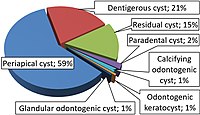
Photo from wikipedia
Background: FHIT (Fragile histidine triad) a member of tumor suppressor family, has been extensively studied in many solid tumors including head and neck squamous cell carcinoma. Among all head and… Click to show full abstract
Background: FHIT (Fragile histidine triad) a member of tumor suppressor family, has been extensively studied in many solid tumors including head and neck squamous cell carcinoma. Among all head and neck cyst and tumors odontogenic lesions account approximately 3%-9%. The molecular pathogenesis of these lesions is less explored. Defects in cell cycle regulators and tumor suppressor genes could result in the development of odontogenic cyst and tumors. Hence, we aimed to determine the significant role of a tumor suppressor gene FHIT in most commonly occurring odontogenic lesions mainly ameloblastoma, odontogenic keratocyst and dentigerous cyst. Subjects and Methods: Immunohistochemical analysis of FHIT was done in ameloblastoma, odontogenic keratocyst, dentigerous cyst and dental follicle. Interpretation of the stained slides were done using standard scoring criteria by two pathologist. The results were subjected for statistical analysis. Results: Expression of FHIT varied among the groups, with highest negative expression in ameloblastoma 44.4% followed by odontogenic keratocyst 14% and 100%positive expression was seen in dentigerous cyst. The expression levels between the groups were statistically insignificant. Conclusion: The varied expression or negative expression of FHIT could be considered as an indicator for aggressive behavior and transformation of preneoplastic/cystic epithelium.
Journal Title: Indian Journal of Pathology and Microbiology
Year Published: 2019
Link to full text (if available)
Share on Social Media: Sign Up to like & get
recommendations!